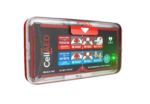Sudden cardiac arrest (SCA) is a leading cause of death worldwide, often striking without warning and leaving little time for an intervention. In these time-sensitive situations, automated external defibrillators (AEDs) play a crucial role in improving survival rates. In this article, we will discuss the importance of early AED use in the event of a cardiac arrest and how having AED units in the home could make a significant difference in outcomes.
The Importance of Early Defibrillation
During a cardiac arrest, the heart suddenly stops beating effectively, slowing blood flow to vital organs. The most common cause of SCA is ventricular fibrillation (VF), a chaotic and disorganised electrical activity in the heart’s ventricles. Early defibrillation is the most effective treatment for VF, as it can restore a normal heart rhythm and enable the heart to resume pumping blood.
The chances of survival decrease by approximately 10% with each passing minute without defibrillation. Therefore, timely intervention is critical in improving survival rates and reducing the risk of long-term complications.
Limited Access to AEDs in Public Spaces
While many public spaces, such as airports, shopping centres, and sports arenas, are equipped with AEDs, their availability remains limited. In many cases, bystanders may not be aware of the location of the nearest AED, further delaying the initiation of life-saving treatment. This underscores the need for more widespread AED access and public awareness.
The Potential Impact of Home AEDs
A significant proportion of SCAs occur in private residences, so having an AED in the home could make a lifesaving difference. Home AEDs have the potential to dramatically reduce the time between the onset of cardiac arrest and defibrillation, greatly improving the chances of survival.
reduce the time between the onset of cardiac arrest and defibrillation, greatly improving the chances of survival.
In addition to increasing survival rates, home AEDs could reduce the burden on emergency medical services (EMS). By initiating treatment before the arrival of EMS, bystanders can help stabilise the patient and potentially prevent further complications.
Overcoming Barriers to Home AED Adoption
Home AEDs face several barriers to widespread adoption despite their potential benefits, including cost, maintenance, and public awareness. Companies are developing more affordable and user-friendly AED units, such as the compact and intuitive CellAED, to address these challenges. These innovations can potentially make home AEDs more accessible and attractive to the general public.
Furthermore, increasing public awareness and education on using AEDs is crucial in promoting their adoption in private residences. Training courses, public service announcements, and collaboration with healthcare professionals can help raise awareness of the importance of early AED use and encourage more people to invest in home AEDs.
Conclusion
Early AED use is critical in improving survival rates following a cardiac arrest, emphasising the need for more widespread access to these lifesaving devices. Home AEDs have the potential to significantly impact outcomes, particularly when paired with increased public awareness and education. By embracing innovations such as the CellAED and promoting the importance of early defibrillation, we can work toward a future where more lives are saved in the face of sudden cardiac arrest.
CellAED is available from the ProTrainings store or visit www.yourpersonalAED.co.uk


Pingback: CellAED® handheld personal AED unit